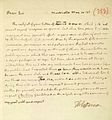File:Jefferson Heaton letter 1826.jpg

Size of this preview: 559 × 599 pixels. Other resolutions: 224 × 240 pixels | 448 × 480 pixels | 746 × 800 pixels.
Original file (746 × 800 pixels, file size: 95 KB, MIME type: image/jpeg)
File history
Click on a date/time to view the file as it appeared at that time.
| Date/Time | Thumbnail | Dimensions | User | Comment | |
|---|---|---|---|---|---|
| current | 12:35, 16 December 2013 |  | 746 × 800 (95 KB) | Gwillhickers | User created page with UploadWizard |
File usage
The following pages on the English Wikipedia use this file (pages on other projects are not listed):
- User:Aguynamedcarl
- User:Alcherin
- User:AllanVolt
- User:AndrewOne/Userboxes/Anti-presentism
- User:Bbx118
- User:Bemule
- User:Burrito74
- User:CalebYJ
- User:CarvigoLD
- User:CaseUnSensitive
- User:Chariotrider555
- User:Comtesse d'Autodidactica
- User:CptFulton
- User:Fitnik2
- User:FrederickOnMars
- User:GnomeMoP
- User:Hallen01
- User:HydroLance
- User:ImNathaniel
- User:InNicoTime
- User:John wiki
- User:Jtrrs0
- User:Kaiserlicher Ritter
- User:Lemminaid
- User:Liam2520
- User:Locust Valley
- User:LordVaal IV
- User:Massimo510
- User:Miamiamyrose/Userboxes
- User:Mlidd99
- User:Nahiyan567
- User:NeoKahuna
- User:Peter Greenwell/blychau
- User:RadioactiveBoulevardier/Userboxes
- User:Saniwasgone
- User:StrohIntegral
- User:The Anonymous Gaul
- User:TomReagan90
- User:ToogooMootoo
- User:UBX/Pro-presentism
- User:Vicedomino
- User:Wesleyzhang
- User:Yopienso
- User:Zo0a1
- User:Zoozaz1
- User:Zoozaz1/normal
- User:Zsls
- User:عبدالرحمن4132
- Wikipedia:Userboxes/History
- Wikipedia talk:WikiProject Userboxes/New Userboxes/Archive 41
